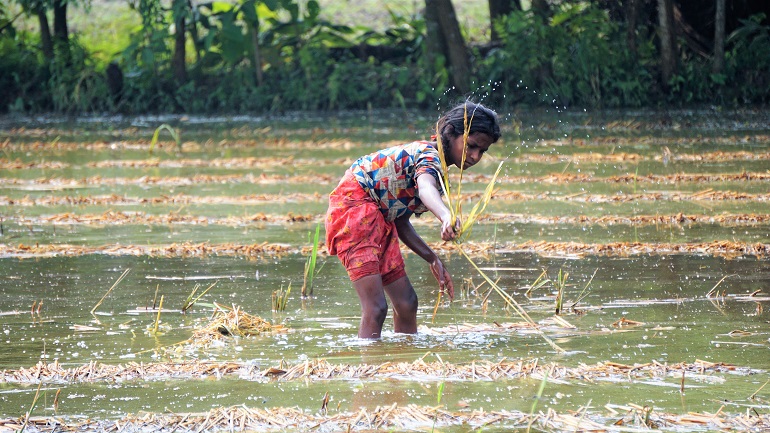Although the impact of atmospheric gas composition on climate has been known since the 1800s, significant research into the possible effects of climate change on agriculture didn’t start until the 1970s. Since then, the highest research focus has been on the impact of changing climate on agriculture. The IPCC has created a number of special publications that are relevant to agriculture, including a comprehensive analysis of agriculture and climate change that was published in 2019(1).
Climate change affects agricultural production, but agricultural production systems can also mitigate or exacerbate climate change dynamics. Agriculture can both act as a significant GHG source and a potential GHG sink.
Impacts of Climate Change on Agriculture
Numerous studies have shown that climate change has already had an impact on agricultural productivity around the world and will continue to do so through rising mean temperatures, altered rainfall patterns, more frequent occurrences of climate extremes (including temperature and precipitation), higher atmospheric CO2 concentrations, and altered patterns of pest pressure(2). The farmers are being challenged to keep operating as a result of the rising climate volatility as they must cope with natural disasters and climate-related challenges in addition to an already harsh agricultural economy. The studies also highlighted the urgent need for adaptation to climate change, which includes changing what is produced, modifying production inputs, implementing new technologies, and adapting management strategies. They also highlighted the policies required but are missing, to provide incentives and support to farmers for these adaptations.
By altering water availability and demand, elevated temperatures significantly contribute to accelerating the rate of drought onset, overall intensity, and drought damage. High temperatures and drought will increase plant stress, lower yields, and deplete surface and groundwater resources due to the increased evaporation rates(3). With poor biomass productivity during drought, soil C will be depleted, which reduces the resilience of agroecosystems. Additionally, the likelihood of soil erosion, surface runoff, and soil C loss is increased by increased precipitation extremes. The increasing precipitation intensity will affect agriculture if farms have not implemented preventive measures to reduce soil erosion and the degradation of water quality, such as the planting of cover crops, conservation tillage, riparian buffers, and waterway protection strips.
Since many commodity crops, including soybeans, wheat, rice, cotton, and others, have yields that start to decline at a certain maximum temperature threshold and horticulture crops are more susceptible to temperature fluctuations, rising temperatures will have an impact on both irrigated and rainfed agriculture. The spread of weeds is likely to be aided by climate change as they respond positively to the levels of atmospheric CO2 and grow more resilient in environments with greater CO2 levels, making conventional pesticides less effective (4). Increased use of petroleum-derived pesticides that represent a major risk to agricultural workers, rural communities, and aquatic and terrestrial ecosystems would result from an increase in crop pests and diseases that are favoured by higher temperatures.
High temperatures associated with drought conditions have a negative impact on pasture and grazing conditions, reducing forage production and, as a result, feed availability for livestock. Heat stress is highly detrimental to dairy cows as it impairs rumen fermentation and reduces milk yield and quality. And the warmer winters are expected to increase disease pressure from livestock pests, parasites, and pathogens on cropland, pastureland, and rangeland, as the increased temperature will result in increased survivability and range expansion of the pests (5) .
Unpredicted climate change feedback events are likely to exacerbate agriculture’s already severe impacts. The amount of precipitation changes as the temperature rises, and severe weather events will become more common and these changes may have both negative and positive feedback loops in agricultural systems in unforeseen ways.
Impacts of Agriculture on Climate Change
Agricultural production generates little Carbon-di-oxide (CO2) but it is a significant source of Methane (CH4) and Nitrous oxide (N2O) emissions. CH4 has a higher global warming potential than CO2 but a shorter atmospheric lifetime. CH4 is 28 times more potent than CO2 over a 100-year period. N2O has a relatively low warming effect but very long atmospheric life, with a global warming potential of about 310 times that of CO2 over a 100-year period. Despite being released in lower overall volumes than CO2, both CH4 and N2O have significantly higher global warming potential than CO2. The largest source of GHG emissions was N2O emissions from agricultural soil management. This occurs as a result of fertiliser application and other agricultural practices that increase N availability in the soil. The second largest source is methane emissions resulting from enteric fermentation and manure management. Another major source of CH4 is rice cultivation, which occurs under anaerobic conditions in flooded fields. Management of manure and field burning of agricultural residues are also minor sources of N2O emissions. Urea fertilisation and liming each account for 0.1 percent of CO2 emissions.
Soils, along with the oceans and forests, are one of the three major global C pools. Soils have the largest terrestrial organic C pool (approximately 1500 Pg C to 1 m depth; 2400 Pg C to 2 m depth), which is three times the amount of CO2 currently in the atmosphere (830 Pg C) and 240 times the current annual fossil fuel missions (10 Pg) (6). Thus, even a small increase in net soil C storage represents a significant sink potential. Soil C sequestration is one of a few low-cost strategies that could be implemented on a large scale.
As land has been converted from forests, native prairie and other grasslands, and wetlands to more chemical-intensive agricultural uses, soil organic C has been depleted. Long-term extractive farming practises, such as deep tillage without soil C rebuilding, have depleted C levels in agricultural soils even further. Globally, agricultural soils have lost an estimated 13 to 28 percent of the C that was initially present prior to cultivation (7). C can be taken up by agricultural soils from root exudates, litter, harvest residues, and animal manures used in agricultural production. A combination of recommended agricultural systems and management practices, as well as the conversion of degraded soils and drastically disturbed, lands to restorative uses, could result in significant long-term soil C sequestration. Particularly on carbon-depleted soils, a rise in soil C has favourable impacts on soil quality and may boost productivity, agricultural resilience, and yield stability.
A study examines the amount of carbon dioxide (C) lost to evaporation due to changes in land use from 1960 to 2017(8), some of which were influenced by agriculture. The findings indicate that there is a tremendous possibility to make up for earlier C loss with careful soil and land management. Practices like (i) creating vegetation barriers, (ii) Herbaceous cover, (iii) Contour strips, (iv) Low tillage, (v) Mulching, etc are referred to as “Soil Health Building Blocks.” These methods improve soil health and do more than only store carbon; they also aid farms in coping with more severe weather through improved water retention, less erosion, and other advantages.
In order to effectively combat climate change, agroecological agricultural methods (Organic Agriculture & Conservation Agriculture) may and must play a significant role. It has been demonstrated that these systems assist farmers in lowering greenhouse gas (GHG) emissions and increasing carbon sequestration in agricultural soils. Increased diversity of systems can enhance SOC sequestration, as well as the ecological and economic resilience of farms to climate change.
In addition to reducing greenhouse gas emissions and adapting to climate change, diverse ecological agricultural systems sustain biodiversity including insects and birds, minimise soil erosion, and save and safeguard water resources.
Author

References
- https://www.ipcc.ch/srccl/
- https://www.sciencedaily.com/releases/2021/04/210401112554.htm
- https://climate.nasa.gov/news/3124/global-climate-change-impact-on-crops-expected-within-10-years-nasa-study-finds/
- Scott, J. K., et al., (2014). AdaptNRM Weeds and climate change: supporting weed management adaptation.
- https://climatechange.chicago.gov/climate-impacts/climate-impacts-agriculture-and-food-supply
- https://www.nature.com/articles/s41598-017-15794-8
- https://www.pnas.org/doi/10.1073/pnas.1706103114
- Lal, R., et al., (2018). The carbon sequestration potential of terrestrial ecosystems. Journal of Soil and Water Conservation, 73(6), 145A-152A.


